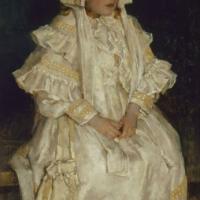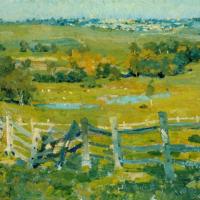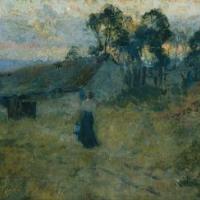E. Phillips Fox
E. Phillips Fox
E. Phillips Fox (1865-1915)
Emanuel Phillips Fox (12 March 1865 – 8 October 1915) was an Australian impressionist painter. After studying at the National Gallery of Victoria Art School in Melbourne, Fox travelled to Paris to study in 1886. He remained in Europe until 1892, when he returned to Melbourne and led what is considered the second phase of the Heidelberg School, an impressionist art movement which had grown in the city during his absence. He spent over a decade in Europe in the early 20th century before finally settling in Melbourne, where he died.
Emanuel Phillips Fox was born on 12 March 1865 to Alexander Fox and Rosetta Phillips at 12 Victoria Parade in Fitzroy, Melbourne, into a legal family whose firm, DLA Phillips Fox, still exists.[1] He studied art at the National Gallery School in Melbourne from 1878 until 1886 under G. F. Folingsby; his fellow students included John Longstaff, Frederick McCubbin, David Davies and Rupert Bunny.
In 1886, he travelled to Paris and enrolled at the Académie Julian, where he gained first prize in his year for design and École des Beaux-Arts (1887–1890), where his masters included William-Adolphe Bouguereau and Jean-Léon Gérôme, both among the most famous artists of the time. While at Beaux Arts, he was awarded a first prize for painting. He was greatly influenced by the fashionable school of en plein airImpressionism. He exhibited at the Paris Salon in 1890, and returned to Melbourne in 1891.
In October 1892, Fox opened the Melbourne School of Art with Tudor St George Tucker, where he taught European ideas and techniques. He had a considerable influence as a teacher on Australian art during this period.
In 1901 he was given a commission under the Gilbee bequest to paint a historical picture of The Landing of Captain Cook for the Melbourne gallery. One of the conditions of the bequest was that the picture must be painted overseas and Fox accordingly left for London.
On 9 May 1905 he married the artist Ethel Carrick in St Peter's Church, Ealing. They toured Italy and Spain, then in 1908 settled in Paris, where he was elected an associate of the Société Nationale des Beaux-Arts. He returned to Melbourne on a visit in that year and held a successful one-man show at the Guildhall gallery. Two years later he became a full member of the Société Nationale des Beaux-Arts, the first Australian artist to attain that honour. He was exhibiting regularly at the Royal Academy. In 1912 he was elected a member of the International Society of Painters and in the same year spent some time painting in Spain and Algeria.
Fox died of cancer in a Fitzroy hospital on 8 October 1915. His wife survived him by 36 years, but there were no children. His nephew Leonard Phillips Fox was a prolific writer and pamphleteer for Communist and humanitarian causes.





